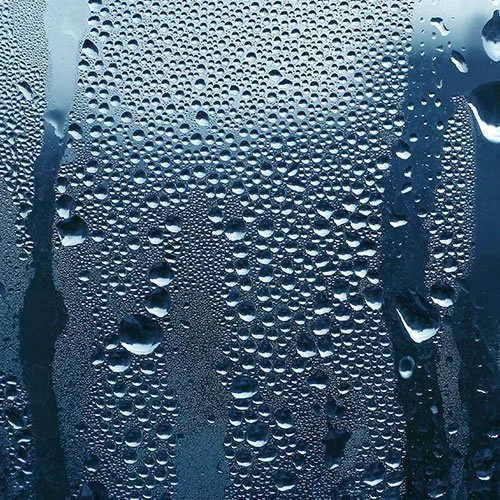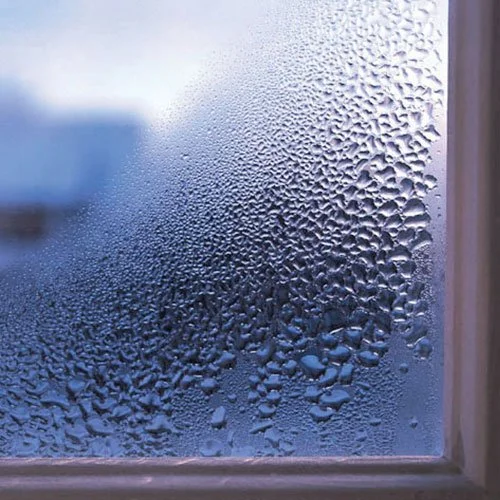
Condensation Facts
What Causes Condensation?
Indoor moisture is caused by a variety of factors. Common household activities such as cooking, showering, running washing machines and dishwashers – every activity that uses hot water – adds moisture to the air. New homes are more often subject to condensation because they are constructed with more weathertight materials than homes built before energy costs were a concern. Weather-stripping, improved insulation, vapor barriers and modern construction techniques are designed to reduce air leakage. At the same time, however, these can act to seal in moisture. Unless provisions are made to allow this moisture to escape, moisture buildup can result.
Condensation on windows is usually a signal of excess humidity in a home. Condensation occurs on windows when warm moist air comes in contact with the colder surface of the window. Although it is natural to assume that the windows are to blame, the fact is that the windows are merely a visible sign that humidity exists in the home.
The right windows can be a great help in controlling condensation and even reducing it, however the best windows available on the market can still have condensation if the temperature and humidity conditions are right.
Can Window Condensation Be Only Temporary?
There are several instances when temporary window condensation can occur, including:
1. During showers and baths, cooking, dish washing and other steam-producing occasions.
2. During the start of each heating season. Houses absorb moisture during humid summers. This will dry out after a few weeks of heating.
3. During sharp temperature changes. Sudden drops in temperature, especially during the heating season, can create temporary condensation problems.
4. During new construction or remodeling. Building materials contain a great deal of moisture. When the heat is turned on, this moisture will flow into the air inside the home. It usually will disappear after the first heating season.
What Can Be Done to Reduce Condensation?
There are many simple steps that can be taken to reduce the humidity level in the home:
Vent clothes dryers, gas burners, etc. to the outdoors.
Check that all ventilation equipment is adjusted properly.
Use kitchen and bathroom exhaust fans.
Air out the kitchen, bathroom and laundry room during and after use by opening a window for a few minutes.
Make sure attic louvers remain open all year round and that crawl spaces are properly ventilated.
Consult a local heating and ventilating contractor to help determine whether ventilation is adequate and whether it can be improved.
Insure humidifiers are correctly set according to outside temperature.
Vinyl Windows Resist Condensation
Windows with vinyl frames help guard against the damaging effects of window condensation because of the higher insulating value of the vinyl. Double and triple-glazed windows are far more effective than single-pane windows in reducing window condensation because they allow higher percentages of relative indoor humidity.
Industry Resources
Energy Star
ENERGY STAR is a joint program of the U.S. Environmental Protection Agency and the U.S. Department of Energy helping us all save money and protect the environment through energy efficient products and practices.
American Architectural Manufacturers Association
Find product manufacturers, plus access information about performance, certification, installation, and maintenance of fenestration products.
Efficient Windows Collaborative
Efficient Windows Collaborative (EWC) members have made a commitment to manufacture and promote energy-efficient windows. This site provides unbiased information on the benefits of energy-efficient windows, descriptions of how they work, and recommendations for their selection and use. Take a look to learn more!
National Fenestration Rating Council
NFRC is a non-profit organization that administers the only uniform, independent rating and labeling system for the energy performance of windows, doors, skylights, and attachment products. Our goal is to provide fair, accurate, and reliable energy performance ratings.
Better Business Bureau
Our mission is to promote and foster the highest ethical relationship between business and the public through voluntary self-regulation, consumer and business education, and service excellence.
National Association of Home Builders
National Association of the Remodeling Industry
NARI’s Core Purpose is to advance and promote the remodeling industry’s professionalism, product & vital public purpose. Visit this link to find a qualified remodeling professional for your next project.
Window and Door Dealers Alliance
The WDDA’s mission is to represent the interests of retail, wholesale, and installing dealers of new and replacement windows, doors, skylights, and related building products. The WDDA is the only national business organization advancing the interests of independent Window and Door Dealers.
Texas Department of Insurance


